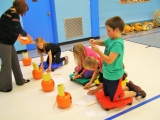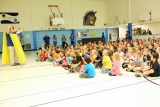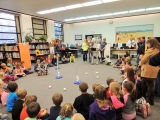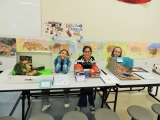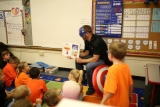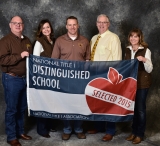-
Category 1
Selected in 2015
-
Grades: k - 5
School Setting: rural
Town Population: 6,476
Student Enrollment: 216
Student Demographics:
Black/African American: 1%
Teacher/Student Ratio: 1:8.7
White/Caucasian: 82%
Hispanic: 12%
Hawaiian/Pacific Islander: 0%
Asian: 0%
Native American: 0%
Other: 5%
% Reduced Lunch: 46%
% ELL Learners: 0.5%
Founded: 1949 -
PRINCIPAL:
Jason Hillman -
CONTACT:
125 S. Douglas St
Powell, WY 82435
307-764-6182
jehillman@pcsd1.org
Parkside Elementary School
Powell, WY
Our journey to ensure learning for all revolves around the PLC model and the four essential questions that drive teaching and learning: What is it we expect our students to learn? How will we know when they have learned it? How will we provide time to support when they don't learn it? How will we expand learning when they already know it or quickly learn it?
- Describe specific programs in place to ensure that families are involved in the success of your school and students.
- Three parent nights a year are provided to promote collaboration between school and home. Parent nights enhance the partnership between school and home in several different ways. First, families are given the opportunity to interact in activities such as hands on math activities during our math carnival. Second, teachers share strategies and activities that are being done at school and equip families and community members with materials they can use at home. Third, parent nights give staff, family and community members a time to celebrate success. One example of these celebrations include students sharing their Young Author’s stories with family and friends around a campfire. These gatherings with staff, family, and friends grant students time to see their family and school work together for them.
- Describe the most successful activity your school has initiated to strengthen ties to your community.
- In order to provide for a successful transition from preschool into kindergarten our district has created a position for a highly qualified teacher to act in the capacity of a Pre-K Transition Liaison. She works closely with our community preschools building rapport, establishing common goals, offering support to students, preschool teachers, and parents, organizing kindergarten screenings, visiting preschools weekly, and also providing two preschool sessions a week in which a parent is required to attend with their child. In this way the parent learns how to work with their child at home to improve their child’s Kindergarten readiness skills. The Pre-K Transition Liaison is an important member of our Kindergarten Team.
- Describe your philosophy of school change or improvement.
- Our belief that ALL children can learn to achieve at high levels drives Parkside's learning environment. We realize that our commitment to continuous improvement requires us to frequently evaluate how to further impact student learning. We believe we need to constantly self-evaluate and be willing to make changes that will promote student learning. We focus on students!
- What are your school’s top two goals for the next year?
-
In an effort to continuously improve, our two top goals for next year are:
1. Refinement of the PLC process
2. Research and implementation of best practice in regards to instruction - What is the single most important factor in the success of your school that others could replicate?
- We believe the single most important factor in the success of our school is putting students first. Our journey to ensure learning for all revolves around the PLC model and the four essential questions that drive teaching and learning: What is it we expect our students to learn? How will we know when they have learned it? How will we provide time to support when they don't learn it? How will we expand learning when they already know it or quickly learn it?
- Describe the program or initiative that has had the greatest positive effect on student achievement, including closing achievement or opportunity gaps, if applicable.
- All of our students are placed in groups to support, promote, or advance their learning depending on data collections. These groupings are flexible and are monitored and adjusted frequently. Both intervention and enrichment is built into these groupings. This proactive approach lends itself to providing the differentiated instruction necessary to meet our students’ needs.
- Explain how Title I funds are used to support your improvement efforts.
-
Parkside Elementary is a school-wide Title I school. From fall of 2012-spring of 2015 our Title I staff consisted of one half-time teacher and four part-time para-professionals. For the 2015-15 school year, Parkside reconfigured staff and schedules to allow for more team collaboration time. Our Title I now consists of one full-time teacher and two part-time para-professionals.
• Grade Level Reading and Math Groups: Title I and other para-professionals support the core learning through small targeted groupings and differentiated instruction (Being proactive).
• School-wide Literacy Intervention: In the fall of 2012 Parkside was able to reconfigure reading intervention time due to changes in Title I personnel. We opted for replacing our full time Title I teacher with a ½ time teacher and extending the hours of a few of our instructional aides. This nearly doubled the intervention contact hours we could provide. An extra two-hour block of time each afternoon was allocated for K-5 reading intervention needs. Schedule changes for the 2015-16 school year, modified that block of time slightly to allow for additional intervention and enrichment (IE groups) in the area of writing. These fluid and flexible groupings are based on student outcomes.
• Collaborative Team Members: (Grade Level PLC Teams and Intervention Team) These Teams, comprised of classroom teachers, Title I teacher, para-professionals, instructional facilitator, and the principal monitor student progress and adjust instruction to meet ALL students’ needs.
• Parent Nights: Three opportunities a year are provided to promote collaboration between school and home.
• After School Program: Our Title I program provides an after-school program to support student learning. This program is staffed by a Title 1 para-professional who supports classroom projects, homework, and skill practice.
• Resources and Materials:
1) Leveled libraries
2) Multi-copies of hundreds of trade books for guided reading practices grades K-5
3) Reading and math games and manipulatives
4) Research-based reading programs
5) Computer Lab
• Professional Development: In recent years Title I monies have funded our in-district professional development as well as conference attendance to train staff in: Professional Learning Communities, Singapore Math, Stephanie Harvey Comprehensive Toolbox, and Daily Five.
• Para-professional training: For the last three years we have started the new school year with training for our para-professionals. Two years ago we delved into aspects of the new Wyoming Standards and the last two years we targeted teaching foundational skills in the primary grades. These trainings were a collaborative effort between the Title I teacher and the instructional facilitator.
- Identify the critical professional development activities you use to improve teaching and student learning.
- Most of our professional development opportunities for the last few years have been in the area of improving classroom instruction. Topics of book studies and video-based classes Parkside has done in recent years include: Essential Questions- Opening Doors to Student by McTighe and Wiggins; Classroom Instruction that Works: Research Based Strategies for Increasing Student Achievement by Marzano,; How to Give Effective Feedback to your Students by Brookhart; Creating Critical Readers class led by Beers and Probst; Notice and Note and When Kids Can’t Read; and Building Academic Vocabulary by Marzano. Our main focus last year was on The Power of Professional Learning Communities at Work by DuFour, Eaker, and Dufour. This year each PLC team has chosen a text to enhance instruction in literacy. Some titles include: Scaffolding Young Writers, Comprehension Connection, Guiding K-3 Writers to Independence. This type of professional development will be ongoing within each PLC team.
- Describe how data is used to improve student achievement and inform decision making.
- Parkside administers benchmark assessments multiple times a year to collect current performance information about our students. These benchmark assessments play a major role in forming classroom reading, writing, and math groups, as well as determining intervention needs for our K-5 students. Benchmark assessments provide our educators with the detailed information they need to craft instruction to meet ALL students’ needs. Individual student data is shared with the students who create personal growth goals. Common classroom formatives drive our day-to-day intervention and enrichment decisions.
- Describe your school culture and explain changes you’ve taken to improve it.
-
We believe that all students can learn to achieve at high levels. Our desire is to improve instruction and learning for all of our students. This school year, under experienced leadership, Parkside is working toward becoming an effective Professional Learning Community (as described by Richard and Rebecca DuFour). In order to make that happen we:
• inform/include all concerned stakeholders in purposeful conversations about why changes are necessary,
• adjusted our schedule to allow for more collaborative time,
• identify essential learning outcomes,
• ensure common formative assessments focus instruction on student learning,
• learn how to better analyze data, and have crucial conversations about teaching and learning,
• and above all else-as a staff, we must continue to learn together. We are currently reading quality literature and discussing effective instructional strategies as teams.
Stats
-
Category 1
Selected in 2015
-
Grades: k - 5
School Setting: rural
Town Population: 6,476
Student Enrollment: 216
Student Demographics:
Black/African American: 1%
Teacher/Student Ratio: 1:8.7
White/Caucasian: 82%
Hispanic: 12%
Hawaiian/Pacific Islander: 0%
Asian: 0%
Native American: 0%
Other: 5%
% Reduced Lunch: 46%
% ELL Learners: 0.5%
Founded: 1949 -
PRINCIPAL:
Jason Hillman -
CONTACT:
125 S. Douglas St
Powell, WY 82435
307-764-6182
jehillman@pcsd1.org




